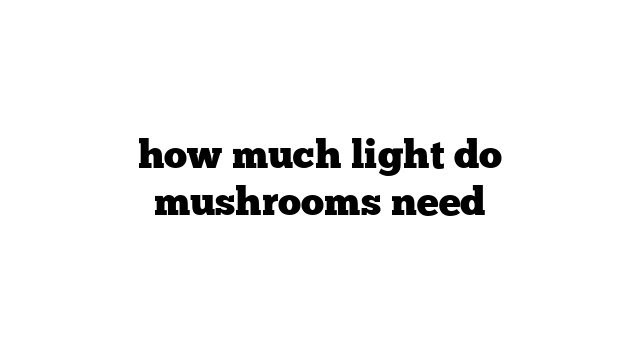Mushrooms are often a fascinating subject for hobbyists and those interested in mycology. Growing mushrooms can be a rewarding and educational experience, but it’s essential to understand the specific needs of these unique organisms. One commonly asked question is how much light mushrooms need for optimal growth. Unlike plants, mushrooms do not rely on photosynthesis for their energy, and their light requirements are quite different. In this article, we will delve into the topic of light and mushrooms, exploring their relationship and how light influences their growth.
## The Role of Light in Mushroom Growth
Before we discuss the light requirements of mushrooms, we must first understand their life cycle and the role light plays in it. Mushrooms are the fruiting bodies of fungi, and their main purpose is to produce spores for reproduction. The actual organism, called mycelium, grows underground or within a substrate, breaking down organic matter and absorbing nutrients. This mycelial network is sensitive to various environmental factors, including light.
While mushrooms do not photosynthesize like plants, they can still benefit from light in different ways. Light can serve as a cue for mushroom formation, triggering the transition from mycelium to fruiting body. Additionally, light can influence the morphology, growth rate, and overall quality of mushrooms. However, excessive or prolonged exposure to light can also have negative effects, such as stunting growth or causing deformities.
## Optimal Light Conditions for Mushroom Growth
When it comes to the amount of light mushrooms need, there is no one-size-fits-all answer. Different mushroom species have varying preferences and tolerances for light. Some mushrooms thrive in low-light conditions, while others require more light exposure. However, it is important to note that mushrooms generally prefer indirect or diffused light rather than direct sunlight.
A common recommendation for mushroom cultivation is to provide a light-dark cycle of 12 hours on and 12 hours off. This mimics the natural day-night cycle and helps regulate the fruiting process. However, it is crucial to remember that this lighting schedule is not mandatory for all mushroom species. Some species may require longer or shorter light-dark cycles, depending on their natural habitat and growth requirements.
## Ambient Light vs. Artificial Light
When it comes to providing light for mushrooms, there are two main options: ambient light and artificial light. Ambient light refers to natural light sources such as windows, skylights, or even nearby lamps. This type of light can be sufficient for some mushrooms, especially those that prefer lower light conditions. Placing your mushroom cultivation setup near a window with indirect sunlight can provide the necessary light cues for fruiting.
Alternatively, artificial light can be used to create a controlled environment for mushroom cultivation. This option allows growers to have more precise control over the light intensity, spectrum, and duration. Artificial lighting systems such as LED grow lights or fluorescent lights can be adjusted to meet the specific light needs of different mushroom species. It is important to choose a light source that emits a spectrum suitable for the growth and development of mushrooms.
## Factors to Consider
While providing the right amount and quality of light is crucial for mushroom growth, there are other factors to consider as well. Here are some additional factors that can influence the light requirements of mushrooms:
### Mushroom Species
Different mushroom species have evolved in different environments and have adapted to specific light conditions. Some mushrooms prefer shaded areas, while others thrive in more exposed locations. Researching the natural habitat and light preferences of the specific mushroom species you are growing can help you determine their light requirements.
### Growth Stage
Mushrooms have different light requirements at different stages of their life cycle. During the vegetative stage, when mycelium growth is the focus, mushrooms generally require less light. However, during the fruiting stage, when the fruiting bodies are developing, they may benefit from increased light exposure. Adjusting the light intensity and duration to match the growth stage can promote optimal mushroom development.
### Light Spectrum
The spectrum of light can also influence mushroom growth and development. While mushrooms do not need specific wavelengths like plants do for photosynthesis, certain spectrums are believed to enhance growth and stimulate fruiting. Experimenting with different light spectrums, such as full-spectrum or blue and red spectrums, can help optimize mushroom cultivation.
### Light Intensity
The intensity of light refers to the amount of light energy reaching the mushrooms. Light intensity can vary depending on factors such as the distance from the light source and the intensity setting of artificial lights. Some mushrooms may prefer lower light intensities, while others may benefit from higher intensities. It is essential to strike a balance and avoid excessive light exposure, which can lead to stress and undesirable effects.
## Conclusion
In conclusion, mushrooms do not require light in the same way plants do for photosynthesis. However, light plays a significant role in their growth and development. Providing the right amount and quality of light can help trigger fruiting, influence morphology, and enhance the overall yield and quality of the mushrooms. Understanding the light requirements of the specific mushroom species you are growing, adjusting the light cycle and intensity accordingly, and experimenting with different light sources can contribute to successful mushroom cultivation. Remember that while light is important, other factors such as temperature, humidity, and substrate composition also play vital roles in mushroom growth.
